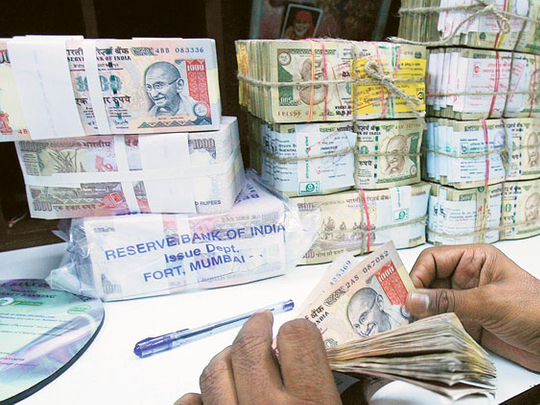
Abu Dhabi: India's rupee is likely to depreciate to around 54 per dollar due to a slowing economy, declining industrial output and runaway inflation, say currency experts.
The rupee went into a freefall on Monday, touching an all-time low of 52.8350 versus the US dollar as industrial production fell for the first time in more than two years.
"The Indian rupee will remain under pressure as its [India's] central bank is unable to tame inflationary pressures in the economy. The inflation has run out of control despite the tightening of monetary policy by the Reserve bank of India in recent months," Mousa Haddad, Head Trader with National Bank of Abu Dhabi, told Gulf News.
"The rupee will depreciate further, if the dollar index breaks above 80 levels," said Haddad.
Sajith Kumar P.K., chief executive of JRG International, Dubai, said the Indian rupee may cross 54.40 to the greenback.
"This might happen during December itself. The dollar has strengthened against all major global currencies due to European sovereign debt concerns and the trend is unlikely to reverse anytime soon," he said. The Indian currency fell 1.5 per cent yesterday, the most in three weeks, as the Central Statistical Office said factory output shrank 5.1 per cent in October from a year earlier. That was the first drop in output since June 2009.
"The bearish sentiment is very strong and there is nothing going for the rupee," J. Moses Harding, a Mumbai-based executive vice president at IndusInd, told Bloomberg yesterday. "The RBI has been intervening intermittently today at various levels."
The Reserve Bank of India sold $943 million (Dh3.46 billion) of foreign currency in October, compared with $845 million the previous month, according to a monthly bulletin on its website yesterday.
Worst performance
The rupee has fallen 15.4 per cent this year, the worst performance among Asian currencies.
The rupee also fell as investors sought the dollar's relative safety on concern European leaders will struggle to contain their region's debt crisis. The Dollar Index, which tracks the US currency's performance against six major trading partners, rose 0.7 per cent.
The Reserve Bank "does not comment on day-to-day market movements," Mumbai-based spokeswoman Alpana Killawala told Bloomberg. The central bank sold $943 million of foreign currency in October, compared with $845 million in the previous month.
Morgan Stanley estimates the Indian currency will fall to 54.80 by the second quarter of 2012. Yesterday, three-month offshore rupee forwards traded at 53.75 to the dollar, compared with 53.25 on December 9.
Three-month offshore rupee forwards traded at 53.75 to the dollar, compared with 53.25 on December 9. Forwards are agreements to buy or sell assets at a set price and date. Non-deliverable contracts are settled in dollars.
Stocks slide
Meanwhile, Indian stocks dropped the most in Asia after the nation's industrial output shrank in October for the first time in more than two years, sending the rupee to an all-time low and narrowing bond yields.
Reliance Industries sank 3.7 per cent, its sharpest loss in more than three months.
State Bank of India tumbled 5 per cent. Factory output contracted 5.1 per cent from a year ago after a revised 2 per cent gain in September, data showed.













